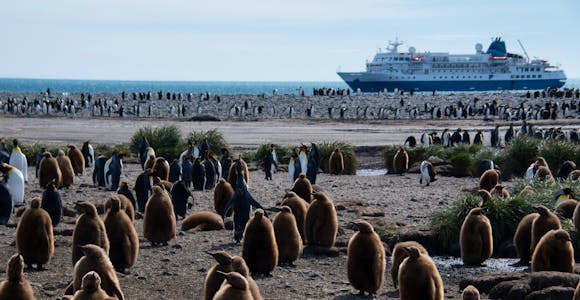
Getting to South Georgia Island
Deep in the Southern Ocean some 870 miles from its nearest neighbour, South Georgia is more challenging (and exciting) to get to than almost anywhere on earth.
Discover MoreSpecial Offers Available: Swoop has access to the widest range of offers and can help you find the right trip, cabin, & price.
Expert impartial advice at no extra cost: no-nonsense advice on 1500 voyages across 30 ships
The Antarctic Experts. No Compromises: there’s no question we can’t answer
The only B Corp certified Antarctic specialist: so your adventures can be a force for good
A full concierge service, unlike booking direct: we leave nothing to chance in delivering your perfect trip
Special Offers Available: Swoop has access to the widest range of offers and can help you find the right trip, cabin, & price.
Expert impartial advice at no extra cost: no-nonsense advice on 1500 voyages across 30 ships
The Antarctic Experts. No Compromises: there’s no question we can’t answer
The only B Corp certified Antarctic specialist: so your adventures can be a force for good
A full concierge service, unlike booking direct: we leave nothing to chance in delivering your perfect trip

South Georgia is a mere speck in the Southern Ocean, but those that make it here discover a true gem: an island covered with spectacular mountains and glaciers traversed by the polar explorer Shackleton and mind-boggling numbers of king penguins and fur seals. A visit here is like stepping into a real-life nature documentary.

King penguins on the beach at St Andrews Bay
South Georgia may be tiny, but it punches far above its weight to offer a wildlife experience like no other. Seals, penguins and other seabirds are counted in the millions: at the height of the breeding season, nowhere else on Earth has such a density of wildlife.
Four species of penguin breed here: gentoos, chinstraps and macaronis, along with the majestic king penguins whose epic colonies are one of the islands biggest attractions. Albatrosses wheel overhead, while you can listen out for the distinctive song of the South Georgia pipit, the world's most southerly songbird, whose numbers are in resurgence after rats were eradicated in 2018.
On the beaches, as many as fur seals crowd the shores, while giant male elephant seals lord it over their harems. In some locations in high summer, the sheer density of seals can make beach landings near impossible. South Georgia's waters are rich feeding grounds for whales.
Although their numbers were devastated by the whaling industry in the last century, humpback whale numbers have almost completely recovered around the island, with fin whale numbers also increasing. Blue and southern right whales remain rare sights. >
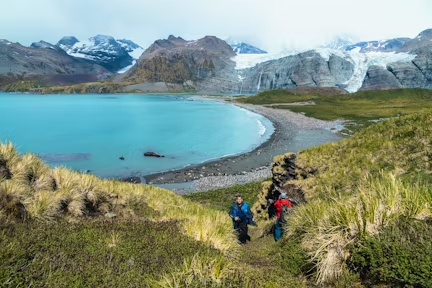
The hike to Gold Head viewpoint above Gold Harbour
South Georgia is spectacularly picturesque. The island is almost completely dominated by a dragon's spine of the Allardyce and Salvesen Mountain ranges that rise straight out of the ocean. Over half the island is permanently covered in snow and glaciers. The highest peak in South Georgia is Mount Paget (2934m/9626 feet). The coastline is crinkled with many fjords and bays that offer sheltered spots for ships to anchor.
There are no trees on South Georgia. In snow-free areas the landscape is dominated by tussock, grassland and peaty bogs. Tussock in particular forms an important breeding location for many bird species, as well as muddy wallows for elephant seals.
Several landing sites are dominated by large glacial outwash plains. These areas are increasing due to South Georgia's fragility in the face of climate change. Some 97% of the islands glaciers that previously terminated in the sea have retreated in the past 50 years. Ironically, this has increased the breeding areas available to species like king penguins, whose numbers have grown in the corresponding period.
Like many small islands South Georgia is highly susceptible to introduced species. In recent years the South Georgia Heritage Trust successfully oversaw a largescale project to eradicate rats, as well as the reindeer that had been introduced by whalers and were overgrazing native plants. A project to control introduced plant species is ongoing.

The abandoned whaling station at Stromness Harbour
The history of this small island is no less intoxicating than the wildlife and scenery, steeped as it is in the history of both Antarctic exploration and the earlier sealers and whalers.
South Georgia appeared on maps with the first sighting in 1675 by London merchant Antoine de la Roche. Then in 1775 Captain James Cook circumnavigated the island and made the first landing, claiming the territory for Great Britain, thereby beginning a long relationship which continues to this day.
Passing observations made in Cook’s reports of significant numbers of fur and elephant seals attracted the unwanted attentions of 18th-century sealers who triggered the first bloody chapter in the island’s history. By the 1830’s the fur seal population had been decimated almost to the point of collapse, leading to the decline of the unchecked sealing industry itself.
This wasn’t the last time though that South Georgia’s natural bounty would fall foul to commercial gain. The establishment of the first land-based whaling station at Grytviken in 1904 provided whalers with their first toe-hold on the island, after which operations expanded with further stations, and it became a base for whaling operations.
Fuelled by Europe’s growing appetite for the oils that whales could provide - mostly for margarine and soap - the whalers headed south. It's estimated the subsequent bonanza over six decades led to approx.1.6 million whales being killed in the Southern Ocean. It wasn’t until 1965 that the whaling stations doors were finally closed forever and left to decay.
Special Offers:Swoop has access to the widest range of offers and can help you find the right trip, cabin, & price.
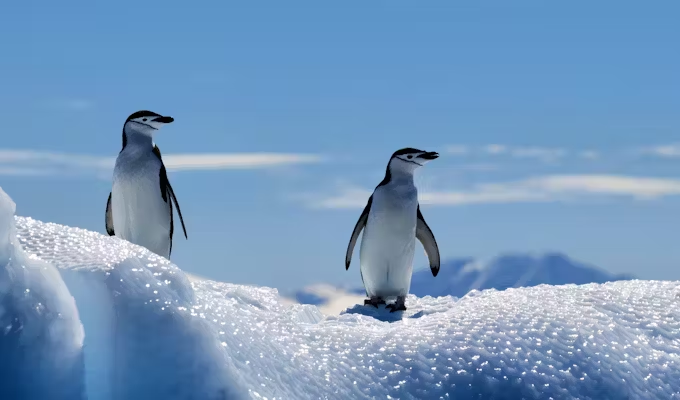
4.6 out of 5
With a good choice of departure dates through the season across three medium-sized ships, this 19-22 day trip stands out for its value for money and the broad range of cabin categories available, including Quads, which are…
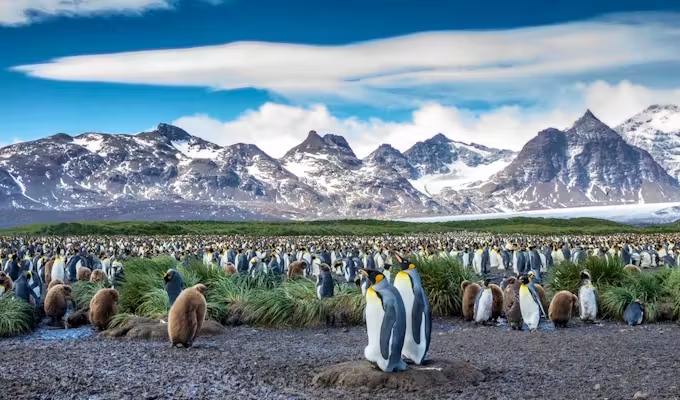
4.9 out of 5
Voyage south in Shackleton’s footsteps, exploring the Southern Ocean's highlights as part of this expansive 20-day adventure. A well-balanced itinerary gives plenty of time in each jaw-dropping location. Explore from the comfort of your sleek purpose-built expedition ship, accompanied by…
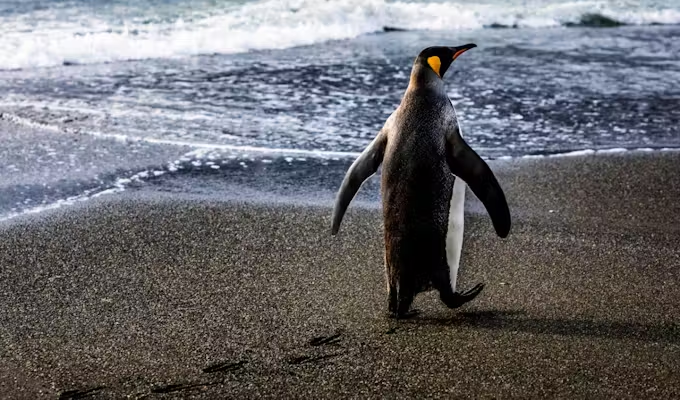
4.6 out of 5
This voyage takes in the wildlife-rich wonders of South Georgia and the Falklands, as well as the dramatic landscapes of the Antarctic Peninsula. You’ll travel on board one of the most exciting new polar ships with spacious cabins, state-of-the-art technology…
South Georgia trips scored 4.5/5 from 249 reviews
We discovered why South Georgia is called The Serengeti of the Antarctic! We were surrounded by hundreds of thousands penguins, fur seals, elephant seals to such an extent that it was sometimes too dangerous to make a zodiac landing as the wildlife on shore was too dense. The landscape and the true wilderness of South Georgia is breathtaking. Read the full review
Travelled: November 2022
Helena Polackova - UK
So many once in a life-time moments. I loved the wildlife encounters: tens of thousands of penguins on the beach; interactions of penguins and fur seal pups. Amazing to watch a leopard seal hunt and catch a penguin. Who knew that icebergs could be so amazing and fascinating? Read the full review
Travelled: February 2022
Scott Hunter - USA
We saw seven different penguin species up close and personal. Five different seal species with amazing encounters with the apex predator "leopard seal". Watching a leopard seal hunt and catch a penguin was nature at its rawest and finest. We saw the complete circle of life from fur seal pups to the demise of a poor gentoo penguin. There were times when the water was boiling with fur seal pups frolicking in the waves. Read the full review
Travelled: February 2022
Scott Hunter - USA
South Georgia was the highlight with so much wildlife and the history. The museum in Grytviken and the church were also very interesting. All the penguins, thousands of them at a time, was very overwhelming at times. Read the full review
Travelled: December 2021
Gordon Pickering - USA
The wildlife in South Georgia was really overwhelming! Read the full review
Travelled: December 2019
Günter Csebits - Austria
I have been to several places where I had seen pictures before I got to my destination and the reality greatly exceeded the pictures. There is no way you can imagine 200,000 nesting pairs of penguins or nesting albatrosses until you have seen them in real life. Read the full review
Travelled: November 2018
Donald Schoengold - United States Of America
There are no words to describe how it feels once you have accomplished a life-long goal. I have now been to South Georgia Island and nothing can take that away from me. Read the full review
Travelled: November 2018
James Jarman - United States Of America
South Georgia was daunting with all 4 seasons in one afternoon!!! It is a trip of a lifetime and we would recommend it as a "Top Priority" on any bucket list.
Travelled: January 2018
Lucien & Marie-Eve - South Africa
The trip was the most amazing experience of our lives! It's difficult to determine what the best moments were, but I would say our time in South Georgia and on the Antarctic Continent were the best.
Travelled: December 2017
Susan & Jay - Washington
South Georgia was fantastic. Seeing the sheer volume of wildlife was incredible. Going early in the season gave us pristine snowy landscapes. We had the unique opportunity to see a lone emperor penguin.
Travelled: November 2017
Janet - California
Review:
As South Georgia doesn’t have enough flat land for an airport, all visitors must arrive by sea. Under usual sea conditions it takes two days to sail to South Georgia from the Antarctic Peninsula, or just over a day from the Falkland Islands.
The closest airport to South Georgia is at Stanley on the Falkland Islands – a small number of voyages may start here, involving a flight to the islands from Punta Arenas in Chile.
For more information see our page Getting to South Georgia.
The visitor season runs from November to March. There isn’t a ‘best time’ to visit as such because South Georgia is such a wildlife dense destination, and you may want to balance the timing with your preferred time to be on the Antarctic peninsula. It's worth noting however that thanks to their unusual breeding cycle, fluffy king penguin chicks will be present whenever you visit.
For more information see our page When to go to South Georgia.
The weather is very windy and variable, and it's more than possible to experience all four seasons in a day. Summer temperatures between November and March, range from 1 to 8°C. The characteristics of the island are very telling of the climate; with 75% coverage of permanent snow and ice.
There’s no accommodation on South Georgia, which is why people visit by expedition ship or the occasional intrepid and self-sufficient yacht.
No – you don’t need a visa to visit South Georgia. Visitor permits are automatically arranged for you if arriving by cruise ship.
Yes – all visitors have their passport stamps when they arrive in Grytviken. This is automatically arranged for you by the team on your expedition cruise ship.

Deep in the Southern Ocean some 870 miles from its nearest neighbour, South Georgia is more challenging (and exciting) to get to than almost anywhere on earth.
Discover More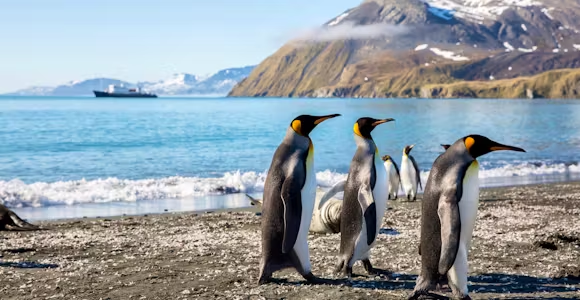
Numbers alone simply can’t explain how extraordinarily abundant and breathtaking the wildlife of South Georgia is: this is the Serengeti of the Southern Ocean
Discover More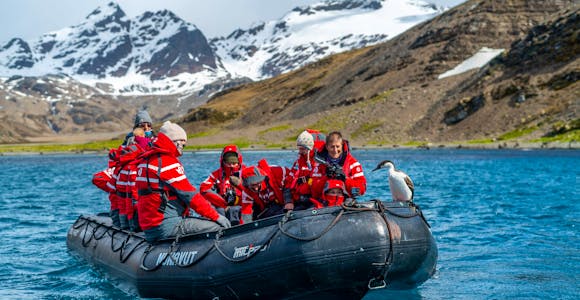
Walk across South Georgia's spectacular landscape, go ashore to meet the abundant wildlife or learn about the island's rich history.
Discover More
The Falkland Islands are a small, remote and thinly populated archipelago that punch well above their size when to comes to amazing wildlife and scenery.
Discover MoreWe'll spend some time listening to your aspirations, then discuss the kind of experience that might suit you.
Next we'll discuss the options, shortlist the best trips for you and present you our impartial recommendations.
We'll place a 24 hour hold on your preferred option - without obligation - whilst we talk through the details.
With over 100 years of South Georgia experience between us, we can help you to exactly the right trip for you.
1-888-970-4570This website uses cookies to ensure you get the best experience on our website. Privacy policy